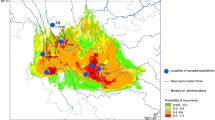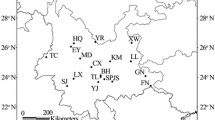Abstract
Variations in the phenotypic characteristics of conifer needles is a consequence of genetic evolution that has been widely used in geographic variation and ecological studies. Although many studies are based on an in situ sampling strategy and generally realize the contribution of environmental effects to variation in needle traits, it is still uncertain which needle traits are most influenced by genetic effects and which are most influenced by the environment. Using both a common garden experiment to eliminate environmental heterogeneity and an in situ sampling strategy, we compared 18 Pinus tabuliformis needle traits among 10 geographical populations. Using both sampling strategies, we found significant differences in needle traits among populations and among individuals within populations. Differences in the “among-population” variance component between the two sampling strategies revealed the environmental contribution among natural populations for each trait. The among-population variance in the following traits exceeded 8%: needle length, number of stomata within 2 mm (NS2), number of stomatal lines on the planar side, number of resin canals (RCN) and the resin canal area (RCA). For the stability of needle traits, NS2, RCN, RCA, ratio of the vascular bundle area to the RCA (VBA/RCA), and MA/RCA differed significantly in more than five provenance changes between the common garden populations and natural populations, which may be susceptible to environmental effects. Conversely, the cross-sectional area, mesophyll area (MA), MA/(VBA + RCA), and MA/VBA were phenotypically stable. Geographic variation patterns and systematic relation of needle traits differed between the two sampling strategies, suggesting that in situ sampling results may reflect environmental effects and deviate statistical parameters for genetic study. Future studies of genetic evolution in the context of geographic variation should be based on appropriate sampling strategies and stable phenotypic traits.




Similar content being viewed by others
References
Androsiuk P, Kaczmarek Z, Urbaniak L (2011) The morphological traits of needles as markers of geographical differentiation in European Pinus sylvestris populations. Dendrobiology 65:3–6
Bobowicz MA, Korczyk AF (1994) Interpopulational variability of Pinus sylvestris L. in eight Polish localities expressed in morphological and anatomical traits of needles. Acta Soc Bot Pol 63(1):67–76
Bobowicz M, Krzakowa M (1986) Anatomical differences between Pinus mugo Turra populations from the Tatra Mts., expressed in needle traits and in needle and cone traits together. Acta Soc Bot Pol 55:275–290
Boratyńska K, Bobowicz M (2001) Pinus uncinata Ramond taxonomy based on needle characters. Plant Syst Evol 227(3):183–194
Boratyńska K, Boratyński A (2007) Taxonomic differences among closely related pines Pinus sylvestris, P. mugo, P. uncinata, P. rotundata and P. uliginosa as revealed in needle sclerenchyma cells. Flora Morphol Distrib Funct Ecol Plants 202(7):555–569
Boratyńska K, Jasińska AK, Boratyński A (2015) Taxonomic and geographic differentiation of Pinus mugo complex on the needle characteristics. Syst Biodivers 13(6):581–595
Chazot N, Panara S, Zilbermann N, Blandin P, Le Poul Y, Cornette R, Elias M, Debat V (2016) Morpho morphometrics: shared ancestry and selection drive the evolution of wing size and shape in Morpho butterflies. Evolution 70(1):181–194
Chen K, Abbott RJ, Milne RI, Tian XM, Liu J (2008) Phylogeography of Pinus tabulaeformis Carr. (Pinaceae), a dominant species of coniferous forest in northern China. Mol Ecol 17(19):4276–4288
Cole KL, Fisher J, Arundel ST, Cannella J, Swift S (2008) Geographical and climatic limits of needle types of one-and two-needled pinyon pines. J Biogeogr 35(2):257–269
Deckert RJ, Hsiang T, Peterson RL (2002) Genetic relationships of endophytic Lophodermium nitens isolates from needles of Pinus strobus. Mycol Res 106(3):305–313
Ding ST, Wu JY, Chen JL, Yang Y, Yan DF, Sun BN (2013) Needles and seed cones of Pinus premassoniana sp. nov., and associated pollen cone from the upper Miocene in East China. Rev Palaeobot Palynol 197:78–89
Donnelly K, Cavers S, Cottrell JE, Ennos RA (2016) Genetic variation for needle traits in Scots pine (Pinus sylvestris L.). Tree Genet Genomes 12(3):1–10
Du QZ, Xu BH, Gong CR, Yang XH, Pan W, Tian JX, Li BL, Zhang DQ (2014) Variation in growth, leaf, and wood property traits of Chinese white poplar (Populus tomentosa), a major industrial tree species in Northern China. Can J For Res 44(4):326–339
Eguchi N, Fukatsu E, Funada R, Tobita H, Kitao M, Maruyama Y, Koike T (2004) Changes in morphology, anatomy, and photosynthetic capacity of needles of Japanese larch (Larix kaempferi) seedlings grown in high CO2 concentrations. Photosynthetica 42(2):173–178
Ghimire B, Lee C, Heo K (2014) Leaf anatomy and its implications for phylogenetic relationships in Taxaceae sl. J Plant Res 127(3):373–388
Guo LD, Huang GR, Wang Y (2008) Seasonal and tissue age influences on endophytic fungi of Pinus tabulaeformis (Pinaceae) in the Dongling Mountains, Beijing. J Integr Plant Biol 50(8):997–1003
Herbin G, Sharma K (1969) Studies on plant cuticular waxes—V. The wax coatings of pine needles: a taxonomic survey. Phytochemistry 8(1):151–160
Huang Y, Mao J, Chen Z, Meng J, Xu Y, Duan A, Li Y (2016) Genetic structure of needle morphological and anatomical traits of Pinus yunnanensis. J For Res 27(1):13–25
Jasińska AK, Boratyńska K, Sobierajska K, Romo A, Ok T, Kharat MBD, Boratyński A (2013) Relationships among Cedrus libani, C. brevifolia and C. atlantica as revealed by the morphological and anatomical needle characters. Plant Syst Evol 299(1):35–48
Jordan L, He R, Hall DB, Clark AI, Daniels RF (2007) Variation in loblolly pine ring microfibril angle in the southeastern United States. Wood Fiber Sci 39(2):352–363
Kajimoto T (1990) Photosynthesis and respiration of Pinus pumila needles in relation to needle age and season. Ecol Res 5(3):333–340
Larsen JB, Mekic F (1991) The geographic variation in European silver fir (Abies alba Mill.). Gas exchange and needle cast in relation to needle age, growth rate, dry matter partitioning and wood density by 15 different provenance at age 6. Silvae Genet 40:188–198
Lexer C, Fay M (2005) Adaptation to environmental stress: a rare or frequent driver of speciation? J Evol Biol 18(4):893–900
Li G, Liu Y, Ma L, Lv R, Yu H, Bai S, Kang Y (2009) Comparison of tree growth and undergrowth development in aerially seeded and planted Pinus tabulaeformis forests. Front For China 4(3):283–290
Li W, Wang X, Li Y (2011) Stability in and correlation between factors influencing genetic quality of seed lots in seed orchard of Pinus tabuliformis Carr. over a 12-year span. PLoS ONE 6(8):e23544
Liang D, Mao J, Zhao W, Zhou X, Yuan H, Wang L, Xing F, Wang X, Li Y (2013) Seedling performance of Pinus densata and its parental population in the habitat of P. tabuliformis. Chin J Plant Ecol 37(2):150–163
Lin J, Jach M, Ceulemans R (2001) Stomatal density and needle anatomy of Scots pine (Pinus sylvestris) are affected by elevated CO2. New Phytol 150(3):665–674
Liu X, Gao C, Su Q, Zhang Y, Song Y (2016) Altitudinal trends in d13C value, stomatal density and nitrogen content of Pinus tabuliformis needles on the southern slope of the middle Qinling Mountains, China. J Mt Sci 6(13):1066–1077
Lynch M, Walsh B (1998) Genetics and analysis of quantitative traits. Sinauer Associates Press, Sunderland, pp 107–127
Maley ML, Parker WH (1993) Phenotypic variation in cone and needle characters of Pinus banksiana (Jack pine) in northwestern Ontario. Can J Bot 71(1):43–51
Mao Q, Watanabe M, Imori M, Kim Y, Kita K, Koike T (2012) Photosynthesis and nitrogen allocation in needles in the sun and shade crowns of hybrid larch saplings: effect of nitrogen application. Photosynthetica 50(3):422–428
McKown AD, Guy RD, Klápště J, Geraldes A, Friedmann M, Cronk QC, El-Kassaby YA, Mansfield SD, Douglas CJ (2014) Geographical and environmental gradients shape phenotypic trait variation and genetic structure in Populus trichocarpa. New Phytol 201(4):1263–1276
Meng J, Mao JF, Zhao W, Xing F, Chen X, Liu H, Xing Z, Wang XR, Li Y (2015) Adaptive differentiation in seedling traits in a hybrid pine species complex, Pinus densata and its parental species, on the Tibetan Plateau. PLoS ONE 10(3):e0118501
Morgenstern M (2011) Geographic variation in forest trees: genetic basis and application of knowledge in silviculture. University of British Columbia Press, Vancouver, pp 3–18
Nikolić B, Bojović S, Marin P (2015) Variability of morpho-anatomical characteristics of the needles of Picea omorika from natural populations in Serbia. Plant Biosyst Int J Deal Asp Plant Biol 149(1):61–67
Niu SH, Li W, Li Y (2013) Open pollinated progeny test and stability analysis of seedlot from clonal seed orchard of Pinus tabuliformis. J Northwest For Univ 2:013
Oleksyn J, Modrzýnski J, Tjoelker M, Reich P, Karolewski P (1998) Growth and physiology of Picea abies populations from elevational transects: common garden evidence for altitudinal ecotypes and cold adaptation. Funct Ecol 12(4):573–590
Osada N, Nabeshima E, Hiura T (2015) Geographic variation in shoot traits and branching intensity in relation to leaf size in Fagus crenata: a common garden experiment. Am J Bot 102(6):878–887
Parrish JD (1995) Effects of needle architecture on warbler habitat selection in a coastal spruce forest. Ecology 76(6):1813–1820
Pensa M, Aalto T, Jalkanen R (2004) Variation in needle-trace diameter in respect of needle morphology in five conifer species. Trees 18(3):307–311
Qiang W, Wang X, Chen T, Feng H, An L, He Y, Wang G (2003) Variations of stomatal density and carbon isotope values of Picea crassifolia at different altitudes in the Qilian Mountains. Trees 17(3):258–262
Qualls FJ, Shine R (1998) Geographic variation in lizard phenotypes: importance of the incubation environment. Biol J Lin Soc 64(4):477–491
Razgour O, Juste J, Ibáñez C, Kiefer A, Rebelo H, Puechmaille SJ, Arlettaz R, Burke T, Dawson DA, Beaumont M, Jones G (2013) The shaping of genetic variation in edge-of-range populations under past and future climate change. Ecol Lett 10(16):1258–1266
Reich PB, Oleksyn J, Modrzynski J, Tjoelker MG (1996) Evidence that longer needle retention of spruce and pine populations at high elevations and high latitudes is largely a phenotypic response. Tree Physiol 16(7):643–647
Tobler M, Palacios M, Chapman LJ, Mitrofanov I, Bierbach D, Plath M, Arias-Rodriguez L, García de León FJ, Mateos M (2011) Evolution in extreme environments: replicated phenotypic differentiation in livebearing fish inhabiting sulfidic springs. Evolution 65(8):2213–2228
Urbaniak L, Karlinski L, Popielarz R (2003) Variation of morphological needle characters of Scots pine [Pinus sylvestris L.] populations in different habitats. Acta Soc Bot Pol 72(1):37–44
Wagner GP, Altenberg L (1996) Perspective: complex adaptations and the evolution of evolvability. Evolution 50(3):967–976
Wang MB, Gao FQ (2009) Genetic variation in Chinese pine (Pinus tabulaeformis), a woody species endemic to China. Biochem Genet 47(1–2):154–164
Wang T, O’Neill GA, Aitken SN (2010) Integrating environmental and genetic effects to predict responses of tree populations to climate. Ecol Appl 20(1):153–163
White TL, Adams WT, Neale DB (2007) Forest genetics. CABI Publishing, Cambridge, pp 149–284
Xiao Y (2003) Variation in needle longevity of Pinus tabulaeformis forests at different geographic scales. Tree Physiol 23(7):463–471
Xing F, Mao JF, Meng J, Dai J, Zhao W, Liu H, Xing Z, Zhang H, Wang XR, Li Y (2014) Needle morphological evidence of the homoploid hybrid origin of Pinus densata based on analysis of artificial hybrids and the putative parents, Pinus tabuliformis and Pinus yunnanensis. Ecol Evol 4(10):1890–1902
Xu B, Tao WX (2006) Application of a hand-held slicing method for wood species identification. China Wood Ind 20:41–43
Yang L, Liu Z, Li J, Dyer RJ (2015) Genetic structure of Pinus henryi and Pinus tabuliformis: natural landscapes as significant barriers to gene flow among populations. Biochem Syst Ecol 61:124–132
Yuan H, Li Z, Fang P, Li W, Li Y (2014) Variation and stability in female strobili production of a first-generation clonal seed orchard of Chinese Pine (Pinus tabuliformis). Silvae Genet 63(1–2):41–47
Acknowledgements
We thank Xiaoru Wang (Professor in Umeå university, Sweden) for her valuable edits.
Author information
Authors and Affiliations
Corresponding author
Additional information
Project Funding: This research was funded by the Fundamental Research Funds for the Central Universities (2015ZCQ-SW-02).
The online version is available at http://www.springerlink.com
Corresponding editor: Hu Yanbo.
Electronic supplementary material
Below is the link to the electronic supplementary material.
Rights and permissions
About this article
Cite this article
Meng, J., Chen, X., Huang, Y. et al. Environmental contribution to needle variation among natural populations of Pinus tabuliformis. J. For. Res. 30, 1311–1322 (2019). https://doi.org/10.1007/s11676-018-0722-6
Received:
Accepted:
Published:
Issue Date:
DOI: https://doi.org/10.1007/s11676-018-0722-6




